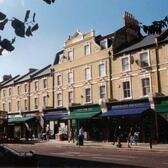Forest Gate Shopping Centre
Region: London
Local Authority: Newham
Owner Type: Many
Funding Body: HERS: English heritage, Public and Private
Year of Intervention: 2000 - 2002
Summary: Forest gate- reviving a dying 19th century suburban shopping centre through the aid of the Historic Economic Regeneration Scheme (HERS).
Description: Forest gate lies in the London Borough of Newham, between Stratford and IIford, both of which have been the subject of major regeneration initiatives.
Issue: Forest Gate’s retail district has suffered a loss of competitiveness over the last ten years. London’s Town Centre Health Checks, published in 1996 by the London Planning Advisory Committee, showed that Forest Gate had lost 399 national ranking points, more than any other town centre in East and South East London. In an area of significant deprivation, this was considered to be of particular concern, since the lack of high-quality local retail provision serves to reinforce social exclusion. When the Woodgrange Estate was recognised as being of architectural interest as a planning estate of the 1880s and designated as a conservation area in 1976, the commercial properties on Woodgrange Road were excluded. The principal terrace, 15-39 Woodgrange Road, was only added in 1999. This terrace was identified as being a set-piece commercial terrace with architectural pretensions, consisting of 13 three-storey buildings, and was architecturally substantially intact, though in need of a major facelift. Ugly alterations had occurred over the years and there was an array of fascia signs and box projection signs creating a cluttered and disjointed appearance to the shopping parade.
Strategy: The Historic Economic Regeneration Scheme (HERS) started in 2000 and the main aim of the scheme was to enhance the external appearance of the terrace through an ‘enveloping scheme’- a programme of external improvement works to roofs, joinery, brickwork and the ‘goal-posts’ of the shop pilasters and fascias. In a terrace like this there are always numerous freeholders, lessees, tenants and sub-tenants. For the scheme to work they all had to sign up to the scheme and agree their contributions. This involved carrying out an assessment of the whole building and identifying the works needed and then producing a highly visual document to show what the terrace could potentially look like. This helped to sell proposals. English Heritage funding of £200,000 levered £216,563 of additional public and private funding.
Outcome: Work commenced in December 2001 and finished May 2002 so it is too early to tell what the long-term benefits of the scheme are at this stage. However, the physical work has made a significant improvement to the impact of this prominent terrace within the primary retail shopping parade in Forest Gate. What is beyond doubt is that the project has shown that it is possible on a limited budget to achieve an effective conservation-led regeneration of a terrace in a deprived part of London. The installation of the new fascia signs, in the original positions and reinstatement of windows according to the original style has created an attractive continuity with the parade. Furthermore, the improvements have safeguarded the jobs of existing employees since owners who previously wanted to sell up are more optimistic about the future of the shopping parade. This optimism is spreading and the London Borough of Newham has now been encouraged to designate the rest of the town centre as a conservation area, and proposing two further phases of the scheme, for other groups of shops in Woodgrange Road.
Keywords: Designation, Regeneration, Repair, Reconstruction & Restoration
© English Heritage


